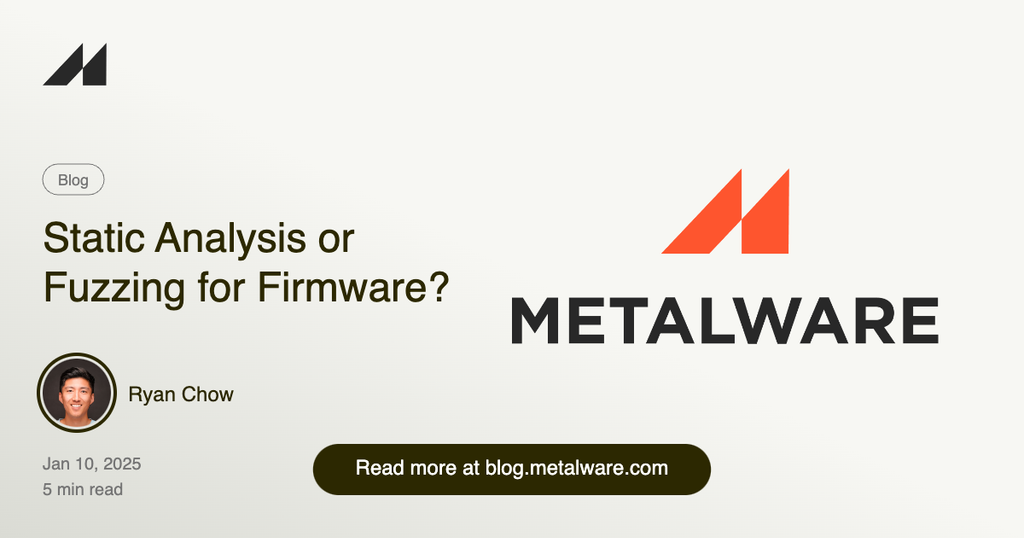Should I Build My Own Firmware Fuzzer?
Firmware fuzzing for microcontroller-based systems presents a unique set of technical challenges. Unlike traditional software fuzzing—typically designed for desktop applications—firmware interacts directly with hardware through mechanisms such as memory-mapped I/O (MMIO), interrupts, and DMA. This blog post discusses the technical challenges in fuzzing firmware.
Technical Challenges Of Firmware Fuzzing
Complex Hardware Interactions
Firmware is tightly coupled with hardware:
- MMIO Handling: Firmware frequently reads from and writes to registers that control peripheral devices. A naive fuzzing approach might consume input data for every register access, even though only a fraction of those bits actually influence firmware behavior. This phenomenon, often referred to as "input overhead," can drastically reduce the efficiency of the fuzzing process.
- Interrupts and Asynchronous Events: Unlike conventional applications that run sequentially, firmware is interrupt-driven. Handling asynchronous events accurately during emulation requires fine-grained modeling to avoid missing critical execution paths.
- Non-Contiguous Input Consumption: Traditional fuzzers assume a contiguous, file-based input. In contrast, firmware typically retrieves inputs in a scattered fashion—each peripheral may consume its own independent stream of data. This non-linear input pattern makes it challenging to design effective mutation strategies.
Emulation and Re-hosting Complexities
Re-hosting firmware—running firmware in an emulated environment—requires precision:
- Precise MMIO interactions: Emulators like QEMU are powerful for full-system emulation, but they use coarse-grained models for hardware interactions. Accurately emulating MMIO behavior requires manual configuration of hardware registers, interrupt controllers, and timing mechanisms.
- Input Overhead management: In many firmware applications, a single peripheral access might only utilize a small subset of the available bits. Without intelligent input handling, fuzzers may waste significant resources by mutating irrelevant data, resulting in reduced code coverage and slower discovery of vulnerabilities.
- State and Path Explosion: Firmware often has many execution paths, some of which are only reachable with very specific input conditions. Building a solution that can intelligently guide the fuzzing process—without inadvertently eliminating important paths—requires expertise in both firmware architecture and dynamic analysis techniques.
Limitations of OSS Fuzzing Frameworks
Many popular fuzzers are designed around the needs of desktop applications:
- Flat input file: Tools like AFL++ expect input to be read as a single contiguous file. This assumption does not hold for firmware, where inputs may be consumed from multiple independent streams. This misalignment leads to unstable mutation behavior, where a small change in one part of the input can cause unintended effects elsewhere.
- No sanitization: Many desktop fuzzers rely on observable crashes (e.g., segmentation faults) to signal bugs. In embedded environments, however, subtle memory corruptions may not immediately cause a crash, leading to “silent” vulnerabilities that remain undetected with conventional methods.
The Hidden Cost
Developing an in-house firmware fuzzing system is challenging:
- Domain Expertise: Crafting a solution that accurately models MMIO, manages multi-stream input, and handles asynchronous events demands significant investment in both time and specialized knowledge.
- Engineering Resources: Tackling these technical challenges requires firmware and cybersecurity expertise, delaying time-to-market and straining internal resources.
- Maintenance and Improvement: As firmware evolves and new types of hardware are tested, the solution must be continually updated. It is an ongoing effort to maintain.
Metalware
Metalware’s automated firmware fuzzer has been engineered specifically to address these challenges:
- Custom Emulation Engine: Using custom emulation techniques, our solution automatically models MMIO behavior and peripheral interactions. This minimizes input overhead and eliminates the need for manual configuration.
- MMIO Handling: Instead of relying on a single, file-based input like AFL++, our fuzzer intelligently handles peripheral inputs. This design enables precise, peripheral-specific mutation strategies that drive deeper code exploration.
- Enhanced Fault Detection: Our system incorporates advanced instrumentation to detect not only obvious crashes but also silent memory corruptions. This comprehensive approach ensures that even subtle vulnerabilities are found.
- Resources and Support: Leveraging a commercial partner gives you the advantage of using a product that is developed and continually supported by firmware security experts. This reduces the development overhead and mitigates risks associated with building a custom tool.




